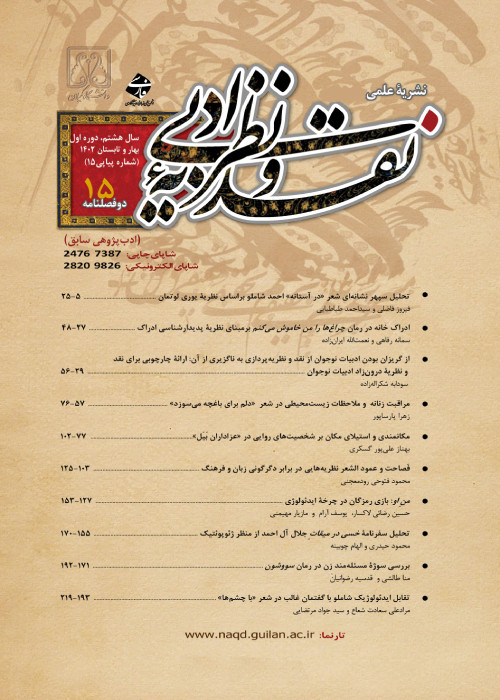Study of Semiotic Codes in “The Tale of the Lion and the Cow” in Kalileh and Demneh
Author(s):
Article Type:
Research/Original Article (دارای رتبه معتبر)
Abstract:
According to Roland Barthes, all texts employ five codes for creating textual signification: the hermeneutic code, the semantic code, the proairetic code, the symbolic code, and the cultural code. The meaning of a text can be understood through opening up these codes. In this article, “The Tale of the Lion and the Cow,” one of the most important chapters of Kalileh and Demneh, has been studied and analyzed based on the following three codes: proairetic, hermeneutic, and semantic. The article shows that the story, containing complicated semantic and coded layers, can be studied based on Bathes’ model, particularly through the three codes listed above. The findings indicate that from the perspective of the proairetic and hermeneutic codes, the narrative includes both a main sequence and a secondary sequence, which are closely connected. Moreover, in the semantic code, the story includes implied significations, with a significant relationship among the elements of the tale, the actions of the characters and the symbolic aspects of the tale. The examination of the semiotic elements help to identify covert layers in the allegories of this important work of Persian literature in which the most central actions are leaving and death, which are consistent with the political atmosphere of the story. Extended Abstract 1.IntroductionNew literary schools and theories can be effectively used to reveal hidden layers in texts and provide us the possibility of new readings of them. According to semiotics, which has been used extensively in the analysis of literary texts, meaning is produced through structures of interdependent signs, codes and contracts. 2.Theoretical FrameworkCodes are of vital importance in semiotics. They turn signs into significant systems and, thus, lead to the development of a relationship between the signifier and the signified. Codes represent the social aspects of signs. Narrative codes were first introduced by Roland Barthes in his reading of Balzac’s “Sarrasine.” He believes that every text is formed through five codes so that textual signification is created. In the present study, Barthes’ concepts are adopted to analyze the codes in “The Tale of the Lion and the Cow” from Kalileh and Demneh. 3.MethodologyUsing Barthes’ semiotic model, “The Tale of the Lion and the Cow” has been analyzed in the present study. For this purpose, instances of these codes were identified and three types of hermeneutic, proairetic and semantic codes were examined. 4.Discussion and AnalysisIn the present study, attempt has been made to examine the semiotic elements and analyze the signs in order to identify covert layers in allegories in an important work of Persian literature. Kalileh and Demneh is replete with political and social allegories. In this article, a semiotic approach is adopted to study the hidden layers and aesthetic signification of this story. Of the five types of codes discussed by Barthes, hermeneutic, proairetic and semantic codes have been focused on in the present article. 5.ConclusionDue to its labyrinthine semantic structure, “The Tale of the Lion and the Cow” has been examined based on Roland Barthes’ theory of codes. Three important codes can be detected in the story, with quite a similar frequency, a quality that is consistent with allegorical literature, in which each layer is closely connected with another layer. This makes it possible for every sign to be interpreted through all the three codes identified in this story. In the semantic code, the story includes implied significations, with a significant relationship among the elements of the tale, the actions of the characters and the symbolic aspects of the tale. In the proairetic code, the narrative includes both a main sequence and a secondary sequence, which are closely connected. The most important actions in this tale are leaving and death, which are consistent with the political atmosphere of the story. Select Bibliography Barthes, R. 1380 [2001]. Marg-e Moallef dar Sakhtargarai, Pasasakhtargarai va Motaleh’at-e Adabi. F. Sojoudi (trans.). Tehran: Pajouheshgah-e Farhang va Honar-e Eslami.Barthes, R. 1394 [2015]. Roland Barthes. N. Fakouhi (trans.). Tehran: Nay.Bruce-Mitford, M. 1394 [2015]. Dayeratolma’aref-e Mosavvar-e Namad-ha va Neshaneh-ha. M. Ansari and H. Bashirpour (trans.). Tehran: Sayan.Chandler, D. 1387 [2008]. Mabani-e Neshaneh-shenasi. M. Parsa (trans.). Tehran: Soureh-e Mehr.Chevalier, J. 1385 [2006]. Farhang-e Namad-ha. S. Fazayeli (trans.). Tehran: Jaihoun.Monshi, N. 1388 [2009]. Kalileh va Damneh. M. Minovi (ed.). Tehran: Amir Kabir.Pierce, C. S. 1381 [2002]. “Mantegh beh Masabeh-e Neshanehshenasi: Nazaryeh-ye Neshane-ha.” F. Sojoudi (trans.). Zibashenakht 6: 51-63.Scholes, R. 1383 [2004]. Daramadi bar Sakhtgarai dar Adabyat. F. Taheri (trans.). Tehran: Agah.Sojoudi, F. 1384 [2005]. Neshanehshenasi va Adabyat. Tehran: Farhang-e Kavosh.
Keywords:
Language:
Persian
Published:
Literary Theory and Criticism, Volume:7 Issue: 1, 2022
Pages:
55 to 77
magiran.com/p2523246
دانلود و مطالعه متن این مقاله با یکی از روشهای زیر امکان پذیر است:
اشتراک شخصی
با عضویت و پرداخت آنلاین حق اشتراک یکساله به مبلغ 1,390,000ريال میتوانید 70 عنوان مطلب دانلود کنید!
اشتراک سازمانی
به کتابخانه دانشگاه یا محل کار خود پیشنهاد کنید تا اشتراک سازمانی این پایگاه را برای دسترسی نامحدود همه کاربران به متن مطالب تهیه نمایند!
توجه!
- حق عضویت دریافتی صرف حمایت از نشریات عضو و نگهداری، تکمیل و توسعه مگیران میشود.
- پرداخت حق اشتراک و دانلود مقالات اجازه بازنشر آن در سایر رسانههای چاپی و دیجیتال را به کاربر نمیدهد.
In order to view content subscription is required
Personal subscription
Subscribe magiran.com for 70 € euros via PayPal and download 70 articles during a year.
Organization subscription
Please contact us to subscribe your university or library for unlimited access!




